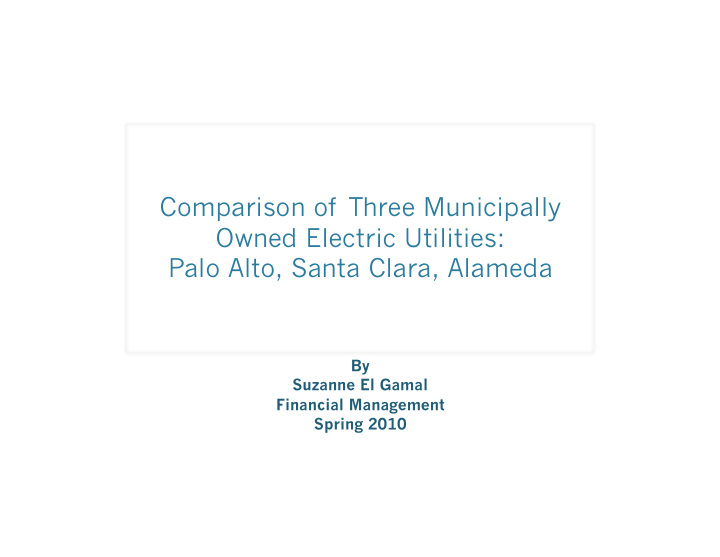



Comparison of Three Municipally Owned Electric Utilities: Palo Alto, Santa Clara, Alameda By Suzanne El Gamal Financial Management Spring 2010
Publicly Owned vs Investor Owned
Publicly Owned Utility CA Legislature Locally Elected Boards Publicly Owned Customer Owners Utility Management and Staff
Investor Owned Utility (IOU) CPUC regulate & approve rates Board IOU & Service Management $$ Customers Share- - & Staff holders $
Method Interview with representatives of each electric utility Obtain CAFR for FY ending June 30, 2009 Calculate Financial Condition Indicators Track Inter-fund transfers from Electric Enterprise Fund into General Fund Compare electricity rates Calculate correlation coefficients to identify factors impacting rate variations
Financial Indicators Financial Process Indicators: Current Ratio Change in Net Assets Budgetary Solvency: Operating Ratio Long-Run Solvency: Net Asset Ratio Long-Term Debt Ratio
Financial Indicators (cont) Service Solvency: Net Asset Per Capita Long-Term Debt Per Capita Financial Results: Total Asset Turnover Fixed Asset Turnover Return On Assets
Current Ratio 60.0 50.0 40.0 30.0 20.0 10.0 0.0 Palo Alto Santa Clara Alameda city
Long-Run Solvency 1 0.8 0.6 Net Asset Ratio (Tot 0.4 Net Assets/ Tot Assets) 0.2 Long-Term Debt Ratio 0 (Tot Long-Term Debt/ Tot Assets) Palo Alto Santa Alameda Clara city
Service Solvency $6,000 $5,000 $4,000 Net Asset Per Capita (Total Net Assets/ $3,000 Population) Long-Term Debt Per $2,000 Capita (Tot Long-Term Debt/Population) $1,000 $0 Palo Alto Santa Clara Alameda
Electric Utility Revenue Relative to Total Utility and General Funds 350,000,000 300,000,000 250,000,000 200,000,000 General Fund Enterprise Fund 150,000,000 Electric Utility 100,000,000 50,000,000 0 Palo Alto Santa Clara Alameda
Electric Utilities Transfers Portion of Total General Fund Revenue 200,000,000 150,000,000 100,000,000 50,000,000 0 Palo Alto Santa Alameda Clara Transfer Gen Fund
Costs vs. Sales 0.1400 0.1200 0.1000 0.0800 Ave Cost per kWh 0.0600 Ave Rate Charged per kWh 0.0400 0.0200 0.0000 Palo Alto Santa Clara Alameda
Customer Composition 100% 95% Other 90% Industrial Commercial 85% Residential 80% 75% Palo Alto Santa Clara Alameda
Correlation Coefficient Factors Relating to Average -1.500 -1.000 -0.500 0.000 0.500 1.000 Net Asset Per Capita Electric Rate Long-Term Debt Per Capita Ave Cost per kWh Tot kWh Sold Tot Electric Utility Fund Residential Customers Commercial Customers Industrial Customers
Critique of Study Method FY 2009 is an isolated snapshot Factors not considered: Effect of economic downturn Effect of dry weather conditions Variable components of power sources for each city Joint ventures of electric utility funds Other investments by electric utility funds Bonds and long-term loans secured by electric utility revenues Capital improvement projects related to electric utility operations
Recommendations Short-term safe investments for Palo Alto’s high liquidity Monitor Santa Clara’s operational deficit and plan to draw down long-term loans, may consider rate increase (actually 7% increase is planned this year and next year) Monitor Alameda’s service solvency and profitability. May benefit from short-term safe investment of funds gained from telecom sale. Watch effect of litigation outcome.
Recommendations (cont) Alameda’s inter-fund transfer for administrative services was almost $4 million. Need to explore line items. Electric rates can be kept low by city increasing its industrial customers
References City of Alameda Charter. Retrieved on May 3, 2010 from http://www.ci.alameda.ca.us/gov/city_charter.html City of Alameda Comprehensive Annual Financial Report. (2009). Retrieved on April8, 2010 from http://www.ci.alameda.ca.us/finance/pdf/cafr_2009.pdf City of Palo Alto Charter. Retrieved on May 3, 2010 form http://www.cityofpaloalto.org/depts/ clk/municipal_code.asp City of Palo Alto Comprehensive Annual Report. (2009). Retrieved on April 8, 2010 from www.cityofpaloalto.org/civica/filefank/blobdload.asp?BlobID=18153 • City of Santa Clara Charter. Retrieved May 3, 2010 from www.codepublishing.com/ca/santaclara/pdf/santachlarach.pdf City of Sata Clara Comprehensive Annual Financial Report. (2009). Retrieved April 8, 2010 from http://santaclaraca.gov/ Coe, C. K. (2007). Governmental and nonprofit financial management. Vienna, VA:ManagementConcepts Johnson, R. (2006). Municipal Electric Utilities – Analysis and case studies. Retrieved on April 8, 2010 from fivestarconsultants.com/Grad…files/ Municipal%20Electric%20Utilities.pdf Morgan Stanley Ratings. February 3, 2010. Northern California Power Agency. Hydroelectric project number one revenue bonds, 2010 refunding series A and 2010 taxable refunding series B. Image Master, Inc.
References (cont) Publicly Owned Electric Utilities: What makes us different? Retrieved April 8, 2010, from http://www.anaheim.net/utilities/anaheim_cmua.pdf U.S. Energy Information Administration. (2010). Electricity explained: Factors Affecting electricity prices. Retrieved April 8, 2010 from http://tonto.eia.doe.gov/Energyexplained/Index.cfm? page=electricity_factors_affecting_prices Wang, X. H. (2006). Financial management in the public sector. New York: M. E. Sharpe, Inc. Interviewed Sources: Ms. Jan Pepper, Alameda Municipal Power, Assistant General Manager energy resource planning Ms. Epek Connolly, City of Palo Alto Utilities, Rates Manager Mr. Mike Pretto, Silicon Valley Power of Santa Clara, Division Manager
Recommend
More recommend